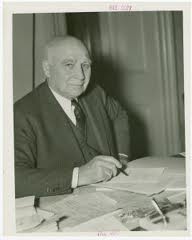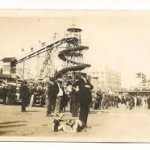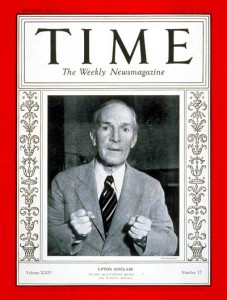Happy Birthday Governor Merriam!
Born December 22, 1865, Frank Finley Merriam – nicknamed “Marble Top” because of his bald pate – became California’s 28th governor on June 2, 1934.
At 68, the Long Beach Republican was the oldest man to become governor until the current occupant of the Capitol’s corner office began his third four-year turn in the wheelhouse at age 72.
Despite his conservatism, Merriam brought California its state income tax – much criticized at the time by Hearst newspapers, among others – as well as an increase to 3 percent in the sales tax and creation of the bank and corporations tax and fuel tax.
California’s first governor to marry in office, Merriam bested Upton Sinclair and his End Poverty in California platform in the 1934 gubernatorial election, which is often cited as California’s first modern political campaign.
A fatal heart attack suffered by “Sunny Jim” Rolph, an ebullient San Franciscan, near the end of his term propelled Merriam, the dour but cagey lieutenant governor, into the governorship on June 2 in the tumultuous year of 1934.
At the time of Rolph’s death, a longshoremen’s strike simmered along San Francisco’s Embarcadero.
It was part of protests along the West Coast over the fairness of deals cut by the International Longshoremen’s Association with cargo companies. Other unions, like the Teamsters, struck in solidarity.
Rolph, the city’s former mayor, was working with other West Coast governors to seek intervention by the US Department of labor to negotiate a settlement.
That option died with Rolph.
Hardly a ship could load or unload at San Francisco’s port. But the city’s Industrial Association – employers – vowed to break the union stranglehold.

PIcketers on the Embarcadero during the 1934 longshoremen strike
“Freight cars on the Belt Line Railroad, which runs the full length of the broad brick and cobblestoned Embarcadero and is owned and operated by the State, were spotted to screen the pier while police cars lined up to keep an open runway,” wrote Time on July 16, 1934 of what had happed at the port July 3.
“Out of Pier 38 thundered five trucks bearing packaged birdseed, coffee, automobile tires. Before sundown, 28 truckloads had been moved safely to a nearby warehouse. Strikers, 3,000 strong, failed to stop the movement.
“Police fought them off with tear gas, firemen with streams of water. Heads were broken, 26 men were injured. But the only trucks stopped were those of some non-combatants not plying to and from the docks.”
On July 5 — later called “Bloody Thursday” – police boxed 2,000 strikers in the three-block Steuart Street, just above Embarcadero.
“In the van of the mob were Howard Sperry and Nicholas Bordloise, longshoremen. Police fired at the fleeing crowd,” Time wrote.
“The crowd rallied. Another volley scattered it but Sperry and Bordloise lay filled with shotgun slugs on the sidewalk of Steuart Street. The police charge drove the strikers up Rincon Hill, on which will rest one end of the $75 million Oakland (Bay) Bridge.
“Work on the bridge stopped as the battle line approached. Up the weed-grown slopes around dilapidated shanties the police fought their way. Amid much cursing, cuffing and clubbing, the strikers were finally dislodged from the summit. “At 5 pm, 1,700 guardsmen marched in, took possession of the piers, set up machine-guns on their roofs. Score for the day: 2 dead, 85 hospitalized.”
Merriam, governor for barely one month, had resisted deploying the National Guard, recognizing the political damage it would cause him.
But “Bloody Thursday” couldn’t be ignored and that same day he issued a proclamation activating the guard because of “tumult, riot and other emergencies” in San Francisco.
The guard was ordered to “take such action or actions as may be necessary for the protection and preservation of life and property and the maintenance of peace and order.”
and the maintenance of peace and order.”
On July 6, Merriam issued this statement:
“The leaders of the striking longshoremen are not free from communist and subversive influences. I know that independent, sincere labor leaders are not sympathetic with the conduct of this strike, and as governor I appeal to the saner, clear-thinking workers to oppose courageously and insistently any effort to involve other groups of labor in a controversy which has gone beyond the bounds of ordinary and legitimate disputes between employers and employees. There will be no turning back from the position I have taken in this matter.”
Sperry and Bordloise’s bodies lay in state at the longshoremen’s association headquarters on Steuart St. But the military presence and police round-ups of the union’s most militant leaders led to peace and, on July 19, an end to the strike and submission to arbitration by federal mediators.
According to a May 1935 article by Time, Merriam used deployment of the guard for political advantage, threatening to withhold troops unless the interest groups backed him as the GOP candidate for governor in November.
The acting governor was declared the party’s nominee to face Upton Sinclair and his End Poverty in California program.
Merriam spent his first 44 years outside of California. He was born in Hopkinton, Iowa and lived there until 1904.
(Iowa’s first territorial governor was Robert Lucas, the great grandfather of Malcolm Lucas, a Long Beach resident and California’s 26th chief justice, whose law partner, also of Long Beach, was George Deukmejian, California’s 35th governor. Deukmejian came to Long Beach in 1955, the year Merriam died there.)
Several years as a principal of Hopkinton schools and a stint as editor of the Hopkinton Leader were followed by election to the Iowa Legislature in 1896 at age 31. In 1898, Merriam was elected state auditor, a post he held for five years.
Merriam and his first wife, Nellie, moved to Long Beach in 1910. Six years later, Merriam was elected to the Assembly.
He increased his political profile sharply by managing the gubernatorial campaign of Republican Friend Richardson in 1922, who ran on a platform of cutting the cost of government.
The Assembly’s GOP majority voted in Merriam speaker in 1923. He was the last speaker to be elected to the state senate.
In 1926, Merriam failed to win the party’s nomination for lieutenant governor but ran successfully for the state senate in 1928. In 1930, he was tapped as GOP gubernatorial candidate Rolph’s lieutenant governor.
To secure his own term as governor, Merriam needed to best Upton Sinclair, author of The Jungle and a former member of the Socialist Party.
Sinclair upset George Creel, a career politician, in the Democratic primary with a message of creating various state authorities that, among other things, would buy shuttered factories where the unemployed could make products which would in turn be traded in exchange for idled or foreclosed property that had been taken over by the California Authority for Land.
Additionally, Sinclair called for abolishing the state’s 2.5 percent sales taxes and instead imposing income taxes as well as taxes on inheritances, banks and utilities.
“We are just about to begin the sixth year of the depression. We have one-and-a-quarter million persons dependent upon public charity and probably as many more who are able to get only one or two days’ work a week or who are dependent upon relatives and friends.
“That is too heavy burden of suffering for any civilized community to carry.”
But the vested interests Sinclair visualized shouldering more of the burden had other plans.
While staying largely above the fray, Merriam’s well-heeled supporters, including Hollywood mogul Louis B. Mayer, pummeled Sinclair.
“It’s Merriam or Moscow,” declared the California Realtors Association in backing the sitting governor. Sinclair sought to increase taxes on real estate.
A 2008 item on the National Association of Realtors website, notes that Merriam installed the presidents and officers of the California Realtors Association for 20 years, both as governor and after he left public office.
Southern California Edison, Southern Pacific, Pacific Mutual and Standard Oil also did their part in portraying Sinclair as a socialist wing nut.
Clem Whitaker and Leone Baxter, founders of the pioneering Bay Area political firm, coordinated the anti-Sinclair campaign.

A Pamphlet from the Negative Campaign Against Sinclair
“Part of the campaign they helped engineer against Sinclair included a flood of negative direct mail pieces, the first time the technique had been sued extensively in a political race,” writes David Mark in Going Dirty: The Art of Negative Campaigning.
“The tracts targeted individual audiences and tailored the messages accordingly, with everyone from university professors to the Boy Scouts receiving their own pieces of mail denouncing Sinclair.”
Even Creel, who was no fan of Merriam, announced he would be voting for the GOP acting governor.
Mayer imposed a “Merriam tax” of one day’s wages on all Metro-Goldwyn-Mayer employees earning $100 or more. James Cagney and Jean Harlow refused to pay.
MGM’s production chief, Irving Thalberg, coordinated the creation of a series of phony newsreels that were sent free to theaters.
“Self-respecting people – filing station attendants, business executives, the decent elderly, stenographers and exceptionally pretty office girls played by Hollywood starlets – told the camera why they were voting for (Merriam),” writes Kevin Starr in Endangered Dreams: Great Depression in California.
“The disheveled and disreputable, on the other hand, many of them with thick foreign accents, stammered their support for Sinclair. ‘Vell,’ said one particularly Bolshevikish gentleman, menacing in his bristling beard, ‘his system worked vell in Russia, vy can’t it vork here?’ “
On October 5, 1934 the Los Angeles Times declared that EPIC represented a “threat to sovietize California.” Said the paper: “This is not politics. It is war.”
The Hearst papers threw their support behind Merriam as well.
Merriam won with 48 percent of the vote to Sinclair’s 37 percent.
Chief fundraiser for Merriam’s campaign was legendary lobbyist Artie Samish who represented Hollywood, racetracks and liquor interests, among others.
According to The Secret Boss of California: The Life and High Times of Art Samish by Bob Thomas, after the election Merriam denied Samish a favor.
Samish replied: “Why, you bald-headed son of a bitch. I helped you get into the governor’s chair. And I’ll get your ass out of it too!”
In his inaugural address Merriam called for balancing the budget, noting the state would end its two-year budget cycle $30 million in red.
Without action, that shortfall would balloon to $100 million during the next two-year cycle, he said
And, in an eerily EPIC move, Merriam then proposed “broadening the so-called tax base.
“It is obvious that if government is to survive and if the needs of the people this emergency are to be properly served, public funds must be raised and disbursed.
The major component of his tax plan was creation of a state income tax.

Merriam at the Dedication of the Bay Bridge
It was repeated amended by Roger Traynor, a Boalt Hall law professor and tax expert who would be appointed to the state Supreme Court by Merriam’s successor.
As signed by Merriam in 1935, the state tax was modeled on the one-year old federal income tax with rates of 1 percent on the first $5,000 of net income up to 15 percent on net income in excess of $250,000 – about 25 percent of the federal rate.
Opposition to the tax was fierce.
Hearst’s papers railed against it.
“Extortionate and confiscatory taxation will mean… devastation of business, paralysis of industry,” wrote the San Francisco Examiner in May 1935.
Said The Argonaut, which the previous year had glowingly endorsed Merriam: “Would Upton Sinclair have done worse in the gubernatorial chair than the man who defeated him? He might even have done better for he has an atom or two of genius in his composition while all one can discern in Merriam is cobwebs from an empty skull.”
Sales taxes were also raised to 3 percent.
A 1936 referendum sought to overturn the tax. It would also have required a two-thirds vote of the Legislature and approval by voters before any new income tax could be imposed.
The proposition lost – just as Merriam would two years later in his re-election bid against Democratic state senator and former EPIC supporter, Culbert Olson.
In 1936, Merriam remarried. His first wife died in 1931. He and his new bride, Jessie Millisack Lipsie, moved into the Governor’s Mansion two days after the ceremony.
Like Merriam, his wife Jessie was bron in Iowa and moved to Long Beach as an adult. As First Lady, she hosted the first “Woman’s Day” on September 8, 1938, in Merriam Hall at the old State Fair grounds in Sacramento.
“Aren’t women wonderful?” she told the 1,100 attendees.
She was active throughout her life in the P.E.O. Sisterhood — Philanthropic Educational Organization — one of the earliest groups formed to push for the advancement of women.
Merriam presided over the completion of the Bay Bridge, which opened November 12, 1936, and the Golden Gate Bridge.
The November issue of California Highways and Public Works described the opening ceremony in oakland this way:
“Here were gathered thousands of men, women and children, many of whom had passed most of the night in their automobiles in order to be among the first to cross the bridge when it was formally thrown open. They came to hear the speeches of prominent officials, leading citizens and the builders of the huge transbay structure themselves, and to see Governor Merriam cut the chain barrier that stretched across the traffic lanes soon to be opened to them.”
Merriam spoke at the dedication of the Golden Gate’s Marin entrance on May 28, 1937 as part of the week long Golden Gate Fiesta.
After Olson beat him, Merriam retired from public life.
He died April 25, 1955 in Long Beach at age 89 — seven years after his wife, Jessie.
-30-
Filed under: California History
Capitol Cliches Conversational Currency Great Moments in Capitol History News Budget and Economy California History Demographics Fundraising Governor Legislature/Legislation Politics State Agencies
Opinionation Overheard Today's Latin Lesson
Restaurant Raconteur Spotlight Trip to Tokyo Venting Warren Buffett Welcome Words That Aren't Heard in Committee Enough




You can see Merriam on the 1934 San Francisco strike at http://www.youtube.com/watch?v=dku-MFnIxaU
Comment by Daniel J.B. Mitchell — 12.23.2011 @ 6:47 am